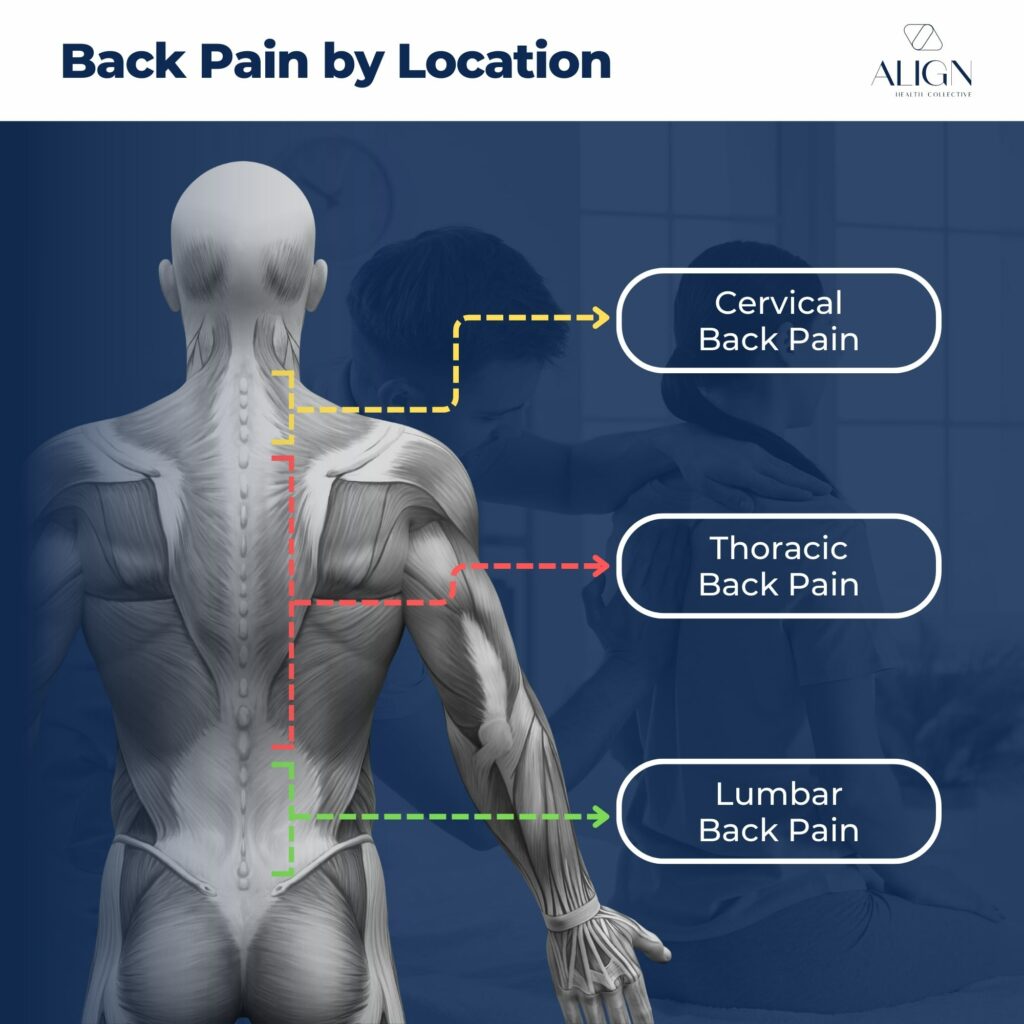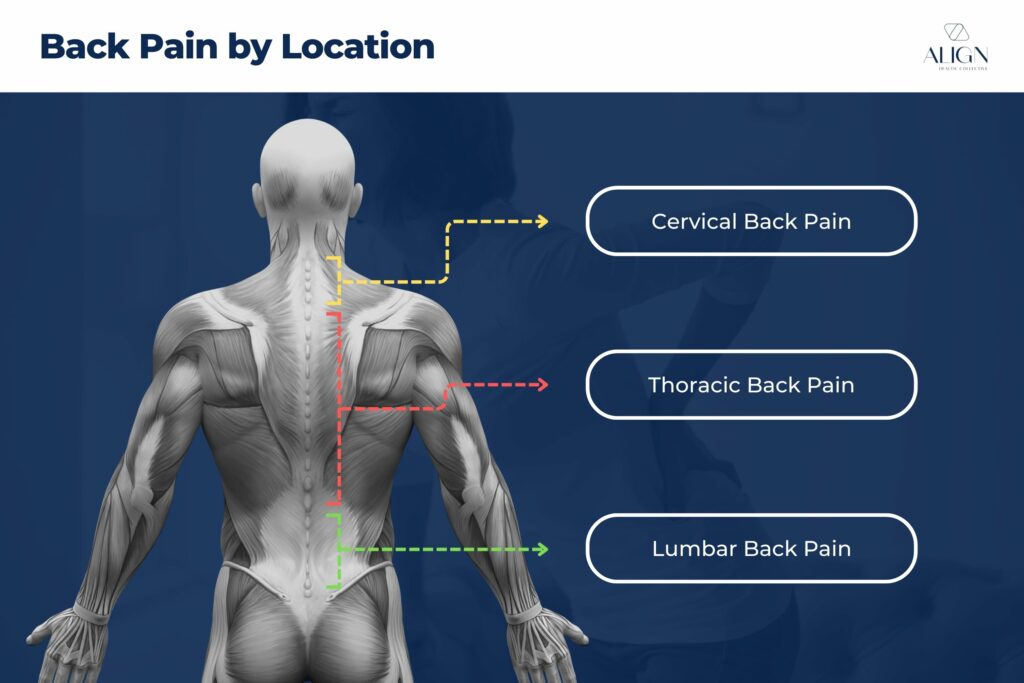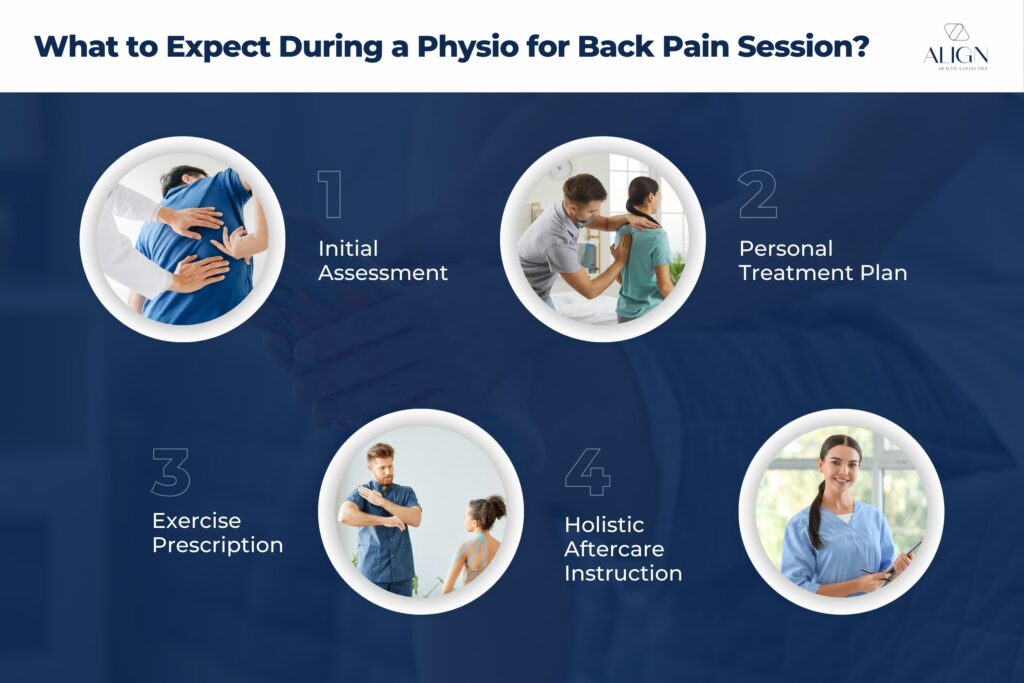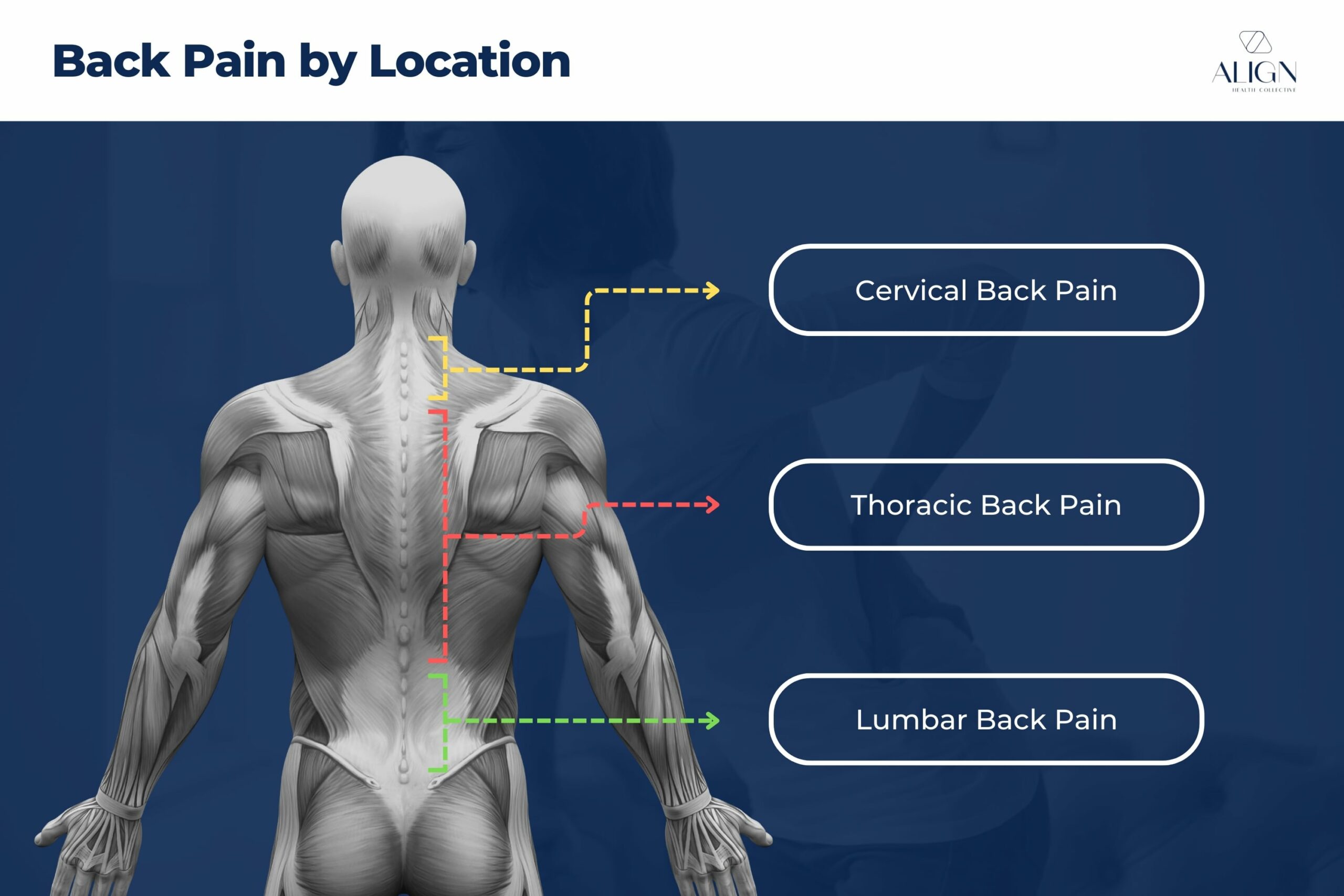Back pain can be debilitating, but there’s light at the end of the tunnel! Physio for back pain could be your best tool for easing aches and improving flexibility. It’s easily accessible and can be effective for all types of back pain.
Without pain in your back, you’ll be able to enjoy your life with newfound freedom of movement. Contact us today to book an appointment and banish your back pain!
What is Back Pain?
Back pain is a common musculoskeletal condition that affects around 4 million people in Australia every year. It can show up anywhere along the spine, from where the spine connects to the skull, right down to the hips. The pain may manifest in different ways depending on the cause and the location.
What Are the Different Types of Back Pain?
Back pain is categorised by location, type of pain, and how long it lasts. Knowing what type of back pain you have is key to treating it. Here’s an overview of the different types of back pain.


Location
- Cervical back pain: Pain in the neck region, often labelled as neck pain rather than back pain.
- Thoracic back pain: Pain in the upper or middle back. If it’s in the area where the ribs attach to the spine, it’s thoracic.
- Lumbar back pain: Any back pain that occurs below the level of your ribs. Also called lower back pain.
Type of Pain
- Axial pain: This is localised to one area. It’s frequently described as dull, throbbing, or constant. Usually caused by muscle strains or issues like facet joint problems.
- Referred pain: This pain that spreads or travels from the source. It’s felt in other areas as well as the back, like the hips or legs. May signal issues like degenerative disc disease.
- Radicular pain: Sharp, electric shock, or burning pain that follows along a compressed spinal nerve. It feels like it’s moving, for example, sciatica from a herniated disc.
Duration
- Acute back pain: Happens suddenly and lasts a few days to a few weeks.
- Subacute back pain: Can have a sudden or gradual onset, lasting between 4 and 12 weeks.
- Chronic back pain: This pain persists for longer than 12 weeks, and you’ll usually feel it every day.
Symptoms of Back Pain
Symptoms of back pain can vary from person to person. It depends on the cause, the type of pain, and the location. Aside from pain, you may also have limited mobility and stiffness as well. You may experience:
- Aching or dull pain: Persistent pain, often localised to the lower back
- Sharp, stabbing pain: Sudden, intense pain that may get worse when you move
- Pain that radiates down your leg: This typically indicates sciatica, a compressed nerve in the lower back. You might feel pain, tingling, numbness, or weakness along the nerve path.
- Stiffness or reduced flexibility: Difficulty bending or twisting without pain
- Muscle spasms: Involuntary contractions that often come with pain
Additional Back Pain Symptoms
- Worsening pain after long periods of sitting or standing
- Difficulty standing up straight or maintaining posture
- Pain that gets worse at night
- Swelling or inflammation in your back
What Causes Back Pain?
Back pain can be caused by overuse or overexertion, musculoskeletal anomalies, medical conditions, and soft tissue injuries. We’ve summarised the most common causes of back pain below.
Common Causes of Back Pain | |
| Muscle or Ligament Strain | Overuse, lifting heavy loads incorrectly, or awkward movements can strain your back muscles and spinal ligaments. |
| Bulging or Ruptured Discs | Your spinal discs act as cushions between the vertebrae in your spine. The soft material inside a disc can rupture and press painfully against a nerve in the back. |
| Arthritis | Wear and tear can lead to arthritic pain in the spine. |
| Skeletal Anomalies | Conditions like scoliosis (curvature of the spine) can lead to back pain, especially as you age. |
| Osteoporosis | Your vertebrae can become porous and brittle, cracking easily. |
| Posture Problems | Poor posture and lack of physical activity can lead to or worsen back pain. |
| Injuries | Accidents and falls can cause mild or severe back pain. This is a result of the vertebrae, muscles, or ligaments being hurt. |
| Stress | Stress can make you tense up your muscles, especially your neck and shoulders. This can lead to chronic back pain. |
| Diseases | Certain diseases, such as cancer, can contribute to back pain if they involve the spine. |
| Lifestyle Factors | Being overweight, leading a sedentary lifestyle, and wearing high heels can increase your risk of developing back pain. |
What Does Physio for Back Pain Do?
Physio for sore back muscles releases tension, improves range of motion, increases flexibility and eases pain in the back, torso, and limbs. Physiotherapists use various techniques to achieve these outcomes. It’s a safe, non-invasive treatment that can benefit almost anyone with an aching back.
Back pain physiotherapy can also help you maintain and strengthen healthy back muscles and ligaments. Regular physio sessions can reduce the chances of back pain happening again.
It’s important to note that physiotherapy can help with all kinds of back pain. Therapy for lower back pain is similar to treatment for upper back pain. What differs is the underlying causes of your back pain.
What to Expect During a Physio for Back Pain Session?


Your physiotherapist will assess you and design your personalised physio for back pain program. Here’s an overview of how your physiotherapy will work:
1. Initial Assessment
Your physiotherapist will perform a comprehensive assessment. This starts with questions about your medical history and how your back pain began. Then, your physio will do a physical examination to identify exactly where your pain is and what kind of pain it is.
2. Personal Treatment Plan
Every treatment plan is unique to the person. Your personal low back rehab plan may include different types of therapy, including:
- Manual therapy: Hands-on techniques like joint mobilisation, massage, or soft tissue release
- Electrotherapy modalities: TENS, ultrasound, and possibly interferential therapy for pain management and tissue healing
- Dry needling: A technique to pinpoint specific trigger points and ease muscle pain
- Taping: Taping techniques can provide support and reduce pressure on painful areas, leading to increased freedom of movement
- Education: Your physio will teach you about proper posture, safe movement patterns for daily activities, and pain management strategies.
3. Exercise Prescription
Your physiotherapist will prescribe specific exercises or stretches for lower back pain or upper back pain. These may include core strengthening, flexibility, and range of motion exercises.
You’ll do some exercises at your physio’s office. But your physio will also give you at-home exercises for back pain. These will build strength, endurance, and muscular resilience over time. This may help prevent the same problem from recurring in the future.
4. Holistic Aftercare Instructions
During your appointment, your physio will discuss ways to speed up your healing process. These could include essentials like sleep, nutrition, exercise, and daily activities.
When to See a Physio for Back Pain
See a physio for low back pain or upper back pain if you experience any of the following:
- Recurring, persistent pain: Pain that doesn’t go away even with at-home treatment
- Limited range of motion: Significant stiffness or inability to move your back freely
- Pain that affects your daily life: Difficulty doing regular activities like walking, sitting, sleeping, or struggling to move as you usually would
- Pain that gets worse over time
- Pain that radiates down your leg or hip
- Additional symptoms like numbness, tingling, or loss of bladder control
How Can You Prevent Back Pain?
You can prevent back pain by making some careful lifestyle changes. Here’s what we recommend:
Maintain Good Posture
Good posture is essential throughout your day. It reduces pressure on your spine. This can help reduce existing back pain and prevent future back pain.
- Standing: Consciously put your shoulders back and down, lift your chin up, and engage your core. Tuck your bottom in by engaging your glute muscles (posterior pelvic tilt).
- Sitting: Support your lower back with a small pillow. Keep your feet flat on the floor and try to keep your knees slightly higher than your hips. Consciously stop yourself from rounding your back.
- Adjust your workstation: Your monitor or laptop should be at eye level. Your keyboard and mouse should be within comfortable reach. Take standing/moving breaks at least every hour.
Exercise and Physical Activity
A combination of stretching and strengthening exercises is ideal. This will strengthen your core muscles (abs, back, and hips) to support your spine, reduce pain, and keep your back muscles flexible. You can easily do the best exercises for lower back pain at home, even after having physio for back pain.
Best Exercises for Back Pain
Do these exercises daily, and your back pain should improve. Prioritise slow, deliberate movement. Quality over quantity!
- Bridge: Lie on your back with your knees bent and your feet on the floor. Lift your hips and keep your shoulders on the floor. You want your body to form a straight line from shoulders to knees. Hold for a few seconds, then lower your hips back to the floor. Repeat up to 10 times.
- Clamshell: Lie on your side with your knees bent and together. Keep your bottom leg on the floor and raise your top knee. Keep your feet together. Hold for a second or two, then lower again. Repeat up to 10 times on each side.
- Superman: Lie on your stomach on a firm surface. Raise your arms, legs, and chest off the floor at the same time. Hold for a second or two, then lower. Do up to 10 reps.
Stretches for Back Pain at Home
Regular stretching can maintain flexibility in your hamstrings, hips, and back muscles. Try yoga or Pilates and add some of the best stretches for lower back pain to your routine.
- Knee-to-chest: Lie on your back. Gently draw one knee towards your chest and hold for 10 to 30 seconds. Repeat with the other leg. Do 3 to 5 reps per leg.
- Hamstring stretch: Lie on your back and place a strap or towel around one foot. Keeping your leg mostly straight, slowly draw the strap towards your body. Hold for 30 seconds on each side.
- Cat-cow stretch: Start on your hands and knees. Round your back like a cat stretching, tucking your chin. Then arch your back downwards, lifting your head and tailbone. Hold each for a few seconds and do 10 to 15 reps in total.
Cardio
Regular cardiovascular exercise can improve your overall fitness and circulation. This keeps your muscles supple and will reduce the need for physio for back pain. Aim for at least 30 minutes of moderate-intensity exercise 5 to 6 days a week. Walking, jogging, swimming, rowing, and jumping rope are all great options.
Important: Always consult your doctor or physiotherapist before starting a new exercise or stretching routine.
Lift Properly
- Bend your knees, not your back. Squat down by bending your knees. Keep your back straight and use your leg muscles to lift. Do not round your back.
- Hold objects close. If you’re holding something heavy, keep it close to your body. Don’t reach out with heavy items in your hands.
- Ask for help. Don’t be afraid to ask for help when lifting awkward or heavy objects.
Maintain a Healthy Lifestyle
Living a healthy life can reduce strain on your back. Follow these tips to keep your back muscles and ligaments healthy:
- Manage your weight
- Follow a healthy, nutritious diet
- Quit smoking
- Invest in a quality mattress and pillow
- Wear supportive footwear and avoid wearing high heels for extended periods
- Avoid sitting for a long time – take short walks or stretching breaks at least every hour
- Listen to your body – ignoring pain signals can make your back pain worse.
Physio for Back Pain FAQs
How long does a physio program for back pain usually last?
A physio for back pain program will generally last for 4 to 8 weeks for mild to moderate back pain. In contrast, treatment for severe or chronic back pain could require several months of physiotherapy.
How do you know if your backache is serious?
Your backache is serious if you have severe, unrelenting pain that lasts for more than 2 weeks without relief. It is also serious if your back pain is accompanied by other symptoms such as fever, numbness or tingling in your legs, loss of bladder or bowel control, and unexplained weight loss. Moreover, if you have back pain after an injury or trauma, be sure to visit your physio.
Should you get a scan (X-rays or MRI) for your lower back pain?
Most people who go for physio for back pain do not need a scan. A thorough physiotherapy assessment will likely pinpoint the source of your pain. If your physio suspects a serious issue, they will refer you for a scan and/or specialist consultation. Together, the results will give them a well-rounded idea of your condition. From there, your physio will be able to decide on the right treatment.
Need physio for back pain? Get in touch and book an appointment with one of our physiotherapists. Prepare to say goodbye to back and hello to your pain-free life!
Back to top: Will Physio for Back Pain Help?
Related Posts:

